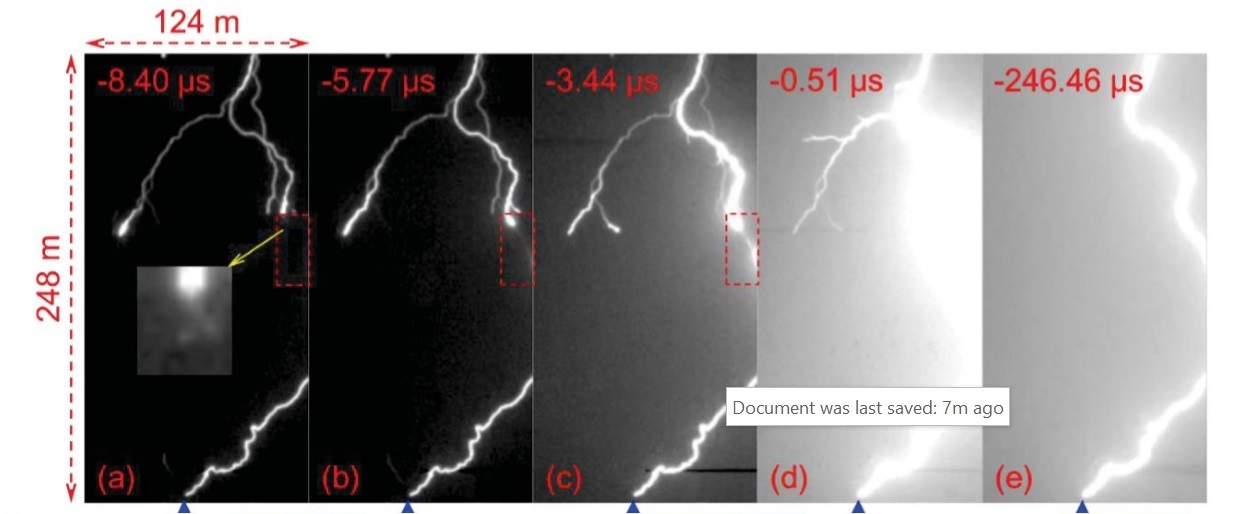Video catches split second before intense lightning strike

Electrifying video footage has captured the moment just before lightning strikes, when thin tendrils of electricity reach down from the sky and up from the ground, until they collide with a dramatic flash.
Using a high-speed camera, researchers captured images of lightning as it struck a 1,066-foot-tall (325 meters) meteorology tower in Beijing. Two consecutive frames, each lasting 2.63 microseconds, show the moment when the downward-reaching and upward-reaching fingers of the lightning bolt suddenly touch, releasing a massive electrical discharge and a bright flash of light.
The images shed light on the so-called breakthrough phase, the instant when the lightning fingers begin to approach each other but have not yet connected. This is one of the "most poorly understood processes in lightning physics," but it's critical for understanding where the lightning will ultimately strike, the authors wrote in a report published Feb. 1 in the journal Geophysical Research Letters.
Book of Incredible Science: $22.99 at Magazines Direct
Journey from our early beginnings as a species, exploring how we came to be and how our immune systems, emotions and even fears developed. Meet some of science’s greatest minds and discover how vaccines were created, the illumination of the light spectrum and how we explain phenomena from "vampires" to out-of-body experiences. Explore the power behind nuclear fusion and the endless possibilities offered by quantum mechanics and more in the "Book of Incredible Science".
Related: Elves, sprites & blue jets: Photos of Earth's weirdest lightning

"The target of the lightning strike is not determined at the beginning when it initiates from the cloud," study co-author Rubin Jiang, an atmospheric physicist at the Chinese Academy of Sciences' Laboratory for Middle Atmosphere and Global Environment Observation, said in a statement. The breakthrough phase "is the process that eventually determines the object that's struck by the lightning flash."
Because the breakthrough phase happens so quickly, scientists have struggled to observe what occurs in those critical moments. The new high-speed camera footage provides a clearer picture of the elusive event.
Lighting begins when a concentration of negatively charged particles builds up in a cloud, causing a complementary positive charge to build up in the ground below, according to the statement. Channels of low-current electricity, called "leaders," descend from the cloud, splitting off into many branches. As these branches near the ground, they attract positively charged leaders that leap from objects below; this leads to the breakthrough phase, when the leaders of opposite charge approach each other.
Get the world’s most fascinating discoveries delivered straight to your inbox.
There are two theories as to what happens when these leaders meet. One theory posits that both leaders emit several lines of electricity, called "streamers." (Think of leaders like long lengths of thread, with streamers as the fraying ends of that thread.) According to the first theory, several streamers from both leaders intertwine to form a single channel of searing-hot plasma. An electrical current can then flow along this channel, causing the lightning flash.
However, the new study supports a different theory. In the footage, instead of many streamers merging to form a plasma channel, only one negative streamer and one positive streamer make a connection.
The video first shows a single downward-reaching leader heading toward one upward-reaching leader. When the leaders come within 75 feet (23 m) of each other, they form a "common streamer zone," and a bright, thin thread of electricity appears between them, connecting their tips. The thinness of the thread suggests that only two streamers merged to form it, the authors wrote. In the following frames, this glowing thread quickly swells into a thick plasma channel that fully merges the leaders, resulting in a luminous flash.
After the two lucky streamers made a connection, the other remaining streamers simply faded away. That said, the study authors need to observe more lightning strikes to confirm that the phenomenon always unfolds this way, according to the statement.
Originally published on Live Science.

Nicoletta Lanese is the health channel editor at Live Science and was previously a news editor and staff writer at the site. She holds a graduate certificate in science communication from UC Santa Cruz and degrees in neuroscience and dance from the University of Florida. Her work has appeared in The Scientist, Science News, the Mercury News, Mongabay and Stanford Medicine Magazine, among other outlets. Based in NYC, she also remains heavily involved in dance and performs in local choreographers' work.



